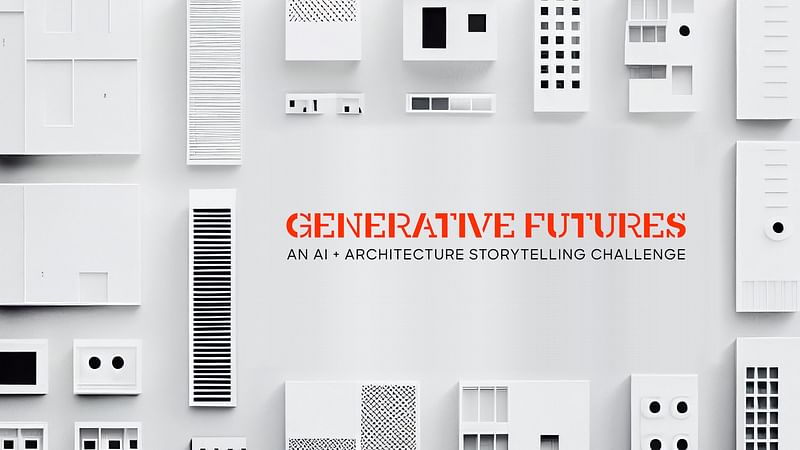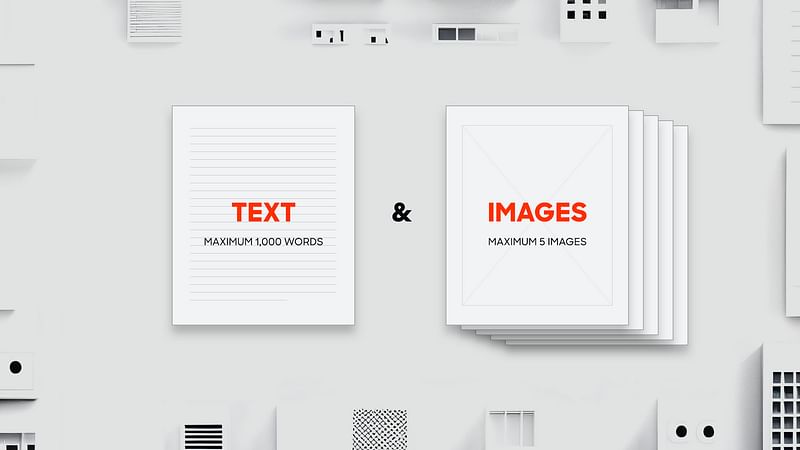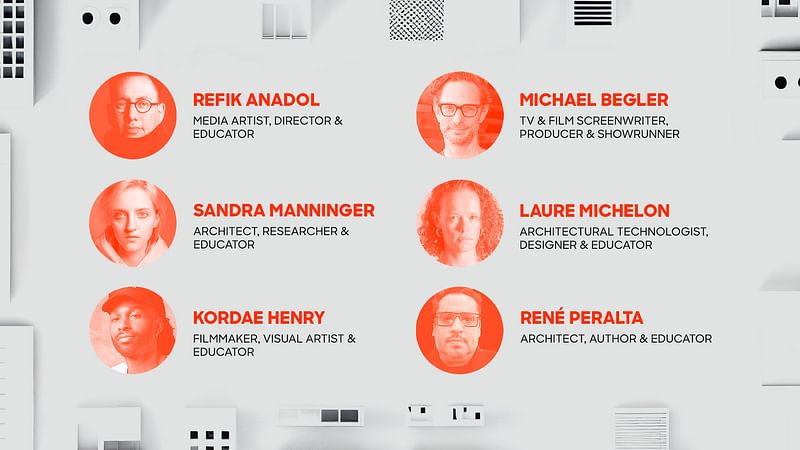Generative Futures: An AI + Architecture Storytelling Challenge
Register/Submit Deadline: Monday, Jun 12, 20236 PMPDT
Related
*Editor's Note: Competition results will be posted the week of July 10th*
PREMISE
“All of a sudden, AI is everywhere. It is on our phones, opening them up through facial recognition, identifying friends on Facebook and feeding us news and advertisements, on our computers, reminding us of meetings, finishing off sentences, and filtering out spam in our homes in the form of Alexa, Cortana, and other AI assistants, controlling robotic floor cleaners and regulating environmental control systems, and in our cars, giving directions, finding parking spaces and notifying us if we stray out of lane. Meanwhile, self-driving cars are already here. AI is changing every aspect of our existence, and architecture is no exception, where it has already infiltrated the architectural office. Embedded in our software tools, it is changing the nature of design.
The hottest topic in progressive schools and practice, AI is now the latest buzzword in architectural culture. Forget Parametricism and 3D printing, the 2020s are all about AI, the first genuinely 21st-century design technique that is revolutionizing architectural culture.”
-Del Campo, M., & Leach, N. (2022). Can Machines Hallucinate Architecture? AI as Design Method. Architectural Design, 92(3).
The term ‘artificial intelligence’ was first coined in 1956. Since then, individual AI systems have matched or outperformed humans in everything from chess and AlphaGo to marketing and navigation. In the past 12 months alone, the consequences of AI, and specifically ‘deep learning,’ on the AEC industry have been propelled to the top of human consciousness through the advent of text-to-image tools such as Midjourney, and outcome-based design software such as Spacemaker.
What does this mean for the future of architecture, architecture studios, architects, creativity, cities, and humanity?
“It’s difficult to make predictions, especially about the future,” said the Danish physicist Niels Bohr.
We cannot predict. But we can dream, forewarn, sculpt, and shape. We can capitalize on the opportunities of AI in the design process, the school studio, the construction site, and the built environment. At the same time, we can confront, question, and remedy the questions posed by AI in the field of architecture and the built environment, be it ethics, surveillance, ownership, representation, or the changing definitions of creativity itself.
“We are called to be architects of the future, not its victims,” said the American architect Buckminster Fuller.

BRIEF
This competition invites entrants to submit a story comprising text and images responding to one of the following four themes, in any way you may interpret them:
- The AI-infused city
- The AI-infused architecture studio
- The AI-infused construction site
- Open Category: entrants may define their own theme as it relates to AI and architecture
The setting, plot, tone, and message of this story are up to you. Is it an allegory? A love story? A horror story? A diary entry? A data-driven prediction? This is your chance to reflect on the relationship between bits and atoms, the artificial and natural, the machine and human, and propagate a scenario that can serve as an invitation for your fellow creatives and the general public to ponder: What should the future relationship be between artificial intelligence and the built environment?
Your submission is permitted to make use of AI-driven text-to-image tools for graphics, and text generation tools for words and scripts, providing such tools are credited in line with the direction in the ‘Submission Components’ section.

Submission Components
- Essay title
- Story text (maximum 1,000 words)
- Story images (maximum 5 images)
- A list of credits at the end of your submission text specifying what, if any, AI and software tools were used in the production of the submission.
Submission Method
The competition has reached the submission deadline and is now closed to new entries. (June 13, 2023)
Submission Fee
There is a $10 (USD) entry fee.
Timeline
- Monday, May 1st, 2023: Competition launch
- Friday, June 2nd, 2023, 6:00 PM PT: Deadline for questions or clarifications
- Monday, June 12th, 2023, 6:00 PM PT: Submissions close
- Week of July 10th, 2023 (updated): Results published
Winning Categories *
- 1x Overall Winner
- 1x Honorable Mentions (AI-infused city category)
- 1x Honorable Mentions (AI-infused architecture studio category)
- 1x Honorable Mentions (AI-infused construction site category)
- 1x Honorable Mentions (Open category)
* Organizers may alter the composition of winning positions in response to the quality of submissions
Prizes
Overall Winner prize pack:
- $500 cash prize
- 1-year subscription to the Morpholio Trace app
- 1-year subscription to the SketchArch Pro app
- Publication on Archinect’s and Bustler’s editorial and social media
Honorable Mentions prize pack:
- 1-year subscription to the Morpholio Trace app
- 1-month subscription to the SketchArch Pro app
- Publication on Archinect’s and Bustler’s editorial and social media
Judging Criteria
50%: Creativity and originality Entry demonstrates unique and innovative perspectives on the relationship between architecture and artificial intelligence. Judges will evaluate how well the story integrates images and text to convey a compelling narrative and captivate the reader’s or viewer’s attention.
50% Impact and relevance Entry has a clear message or theme that is relevant to current challenges, opportunities, or trends in architecture or artificial intelligence. Judges will evaluate the story’s impact on the reader’s understanding and perception of the relationship between these two fields, as well as its potential to inspire future innovations or solutions.

JURY
Refik Anadol (Media Artist, Director & Educator)
Refik Anadol is an internationally renowned media artist, director, and pioneer in the aesthetics of data and machine intelligence. He is also a lecturer in UCLA’s Department of Design Media Arts. His work locates creativity at the intersection of humans and machines. Refik’s site-specific AI data sculptures, live audiovisual performances, and environmental installations take many forms, while encouraging us to rethink our engagement with the physical world, decentralized networks, collective experience, and the creative potential of machines. His work has been exhibited at venues including the Centre Pompidou-Metz, National Gallery of Victoria, Venice Architecture Biennale, Hammer Museum, Dongdaemun Design Plaza, Ars Electronica Festival, Istanbul Design Biennial, and ZKM | Center for Art and New Media. In 2018, Refik Anadol collaborated with the Los Angeles Philharmonic for WDCH Dreams, a live audio-visual performance projected on the façade of Frank Gehry’s iconic Walt Disney Concert Hall in celebration of the orchestra’s centennial. “Refik Anadol: Unsupervised,” his first solo North American museum presentation, is currently on view at The Museum of Modern Art, New York.
Michael Begler (TV & Film Screenwriter, Producer & Showrunner)
Michael Begler has been a working writer in Hollywood for several decades. His resume spans from sit-com to features to prestige television drama. He is probably best known for being a co-creator on the award-winning television series “The Knick,” directed by Steven Soderbergh. Michael is currently acting as showrunner and executive producer of the second season of HBO’s critically acclaimed “Perry Mason.”
Kordae Henry (Filmmaker, Visual Artist & Educator)
Kordae Jatafa Henry is a Los Angeles-based filmmaker and visual artist. The core of his practice stems from a multidisciplinary background, having earned a dual Master of Architecture/Landscape Architecture from University of Pennsylvania School of Design in 2015, as well as a Master of Arts in SCI-Arc’s postgraduate Fiction and Entertainment program in 2018. His release of his 2019 short music film “Earth Mother, Sky Father” has led him to take the stage at the 2019 Design Indaba Conference, become a recent nominee for the shots 2020 Awards’ New Director of the Year, and exhibit his work in museums and festivals all over the world. Through live-action music films, installations, dance, game engine environments, and mythology, Henry’s work invites new ways of seeing humans, folklore, mysticism, pop culture, post-genre music, labor, and creation stories as tools to explore the radical imagination. Most recently, Henry has worked with Sundance New Frontier Lab and ONX Studio to reconstruct a real-time performance exploring the past, present, and future of the Black body through ceremony. He is currently Visual Studies faculty at SCI-Arc.
Sandra Manninger (Architect, Researcher & Educator)
Sandra
Manninger is an architect, researcher, and educator. She is Associate
Professor at the School of Architecture at the New York Institute of
Technology. Born and educated in Austria, she co-founded SPAN
Architecture together with Matias del Campo in 2003. Her award-winning
projects have been published and exhibited internationally, for example,
at La Biennale di Venezia 14/16/18/21/23, the MAK, the Autodesk Pier 1
and have been included in the permanent collections of the FRAC
Centre-Val de Loire, The Design Museum/Die Neue Sammlung in Munich, or
the Albertina in Vienna. Sandra has taught internationally at, among
others, the IAAC and ESARQ in Barcelona, TU Vienna, the University for
Applied Arts, the Bauhaus in Dessau, at Penn Design in Philadelphia, at
Tongji University, Tsinghua University, Taubman College, at the
University of Michigan, and the Royal Melbourne Institute of
Architecture, before joining NYIT.
Laure Michelon (Architectural Technologist, Designer & Educator)
Laure Michelon is an architectural technologist and designer with a focus in architecture, machine learning, energy analysis, and fashion. Her research and practice focus on digital simulation and algorithmic mutations with focused interests in infrastructure systems, machine learning, and fashion. Currently a lecturer at UCLA AUD Technologies Studio, she previously taught at SCI-Arc, was a Project Designer at Ishida Rehm Studio where she worked on projects such as the Architectural Beast, Hoax Urbanism, and New Campo Marzio, a Creative Technologist at Actual Objects, and an Energy Analyst at Glumac. Laure has an M.S. in Architectural Technologies from SCI-Arc and a B.S. in Civil Engineering from Columbia University SEAS.
René Peralta (Architect, Author & Educator)
René Peralta studied Architecture at the New School of Architecture in San Diego and the Architectural Association in London, England. He has a Master of Science in Planning with an emphasis in History and Theory from the University of Oklahoma. Peralta is a co-author with Fiamma Montezemolo and Heriberto Yepez of the book “Here is Tijuana,” Black Dog Publishing, London 2006. He co-edited, along with Tito Alegría and Roger Lewis, the commemorative edition of the book “A Temporary Paradise: A Look at the San Diego Region's special landscape,” published by COLEF in 2018 and initially prepared by Kevin Lynch and Donald Appleyard in 1974. He is the author of the soon-to-be-published short story Border Astronaut which utilizes AI as a method and medium to explore the future US/Mexico border region through a surreal and dreamlike lens. The story challenges conventional ideas of urbanism and architecture while emphasizing the emotional impact of physical barriers and the resilience of those who traverse them. By blurring the lines between reality and dreams and incorporating AI-generated content, the narrative invites viewers to contemplate the potential for reimagining border spaces' design, function, and symbolism more humanely and inclusively.
SPONSORS
Software Prize Sponsors: Morpholio Trace, SketchArch
Media Sponsor: MIT Technology Review
COMPETITION TERMS AND CONDITIONS
Language
English is the official language of this competition.
Eligibility
The competition is open to all individuals. Submissions must be limited to one individual, with group submissions not permitted.
No member or employee of the organizer or sponsor organizations may apply.
Jury decision
The judges’ decision as to winners and commendations is final. Judges reserve the right to declare no winners if entries are of insufficient quality.
Disqualification
Submissions shall be excluded from the competition:
- If an entrant improperly attempts to influence the decision
- If received after the latest time stated under the Submission method (see above)
- If, in the opinion of the organizer, it does not fulfill the requirements of the competition brief
- If any of the mandatory requirements of the brief and conditions are disregarded.
Privacy and Ownership
Entrants must not release their submissions to any third parties until 3 months after the results have been published.
Archinect reserves the right to publicize any or all of any entrant’s submission in any promotional activity, including all social media channels, with due credit given to the entrant.
Inquiries
All inquiries relating to the competition should be directed to: [email protected]

RELATED NEWS Archinect launches new series on Artificial Intelligence and 'Generative Futures' storytelling challenge

RELATED NEWS Generative Futures: An AI + Architecture Storytelling Challenge is open for submissions


Share
0 Comments
Comment as :